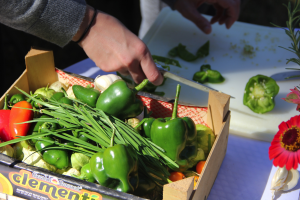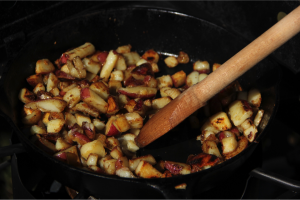Dr. Brian Campbell’s Anthropology of Food course at Berry College explores the interaction between culture and food tradition, including traditions of food-getting, meal preparation, commensality, and food waste. As a community engagement course, this class meets at food pantries, community kitchens, and organic gardens as often as in a classroom. The Anthropology of Food class promotes habits of healthy eating, sustainable food production, and remedies for food insecurity in the local community through service projects, workshops, and community events. This essay documents a meeting for this class in which students gather sustainable ingredients, cook nutritious foods, and engage in commensality.
Vases of Zinnias lined the tables before students began to arrive, cut fresh that morning by one of Dr. Campbell’s daughters. Zinnias are traditionally a flower of friendship, which is very appropriate considering the community that would be built in this class over the semester through meetings like this one. But these flowers also play an essential role in the garden that produced ingredients for this meal. Dogwood Gardens relies on agroecology to grow plants, using methods that value each aspect of nature. The Zinnias attract pollinators like bees and butterflies to the garden, where the insects carry pollen between flowers, ensuring plants in Dogwood Gardens produce healthy fruit and viable seeds.
And the seeds are what really matter for the work that Dr. Campbell’s students conduct at Dogwood Gardens. Although the gardens do produce food, they are primarily used to propagate heirloom plants, and distribute their seeds to the public in order to continue the relevance among traditional farmers who remain. Heirloom varieties are threatened today by industrial agriculture, which emphasizes monoculture growth of a single variety and destroys traditional knowledge of agricultural practices in the process. As opposed to genetically modified plants grown in industrial farming, heirloom varieties are open-pollinated, allowing pollinating insects to pollinate naturally. Each natural thing at Dogwood Gardens plays a role in producing seeds, from the chickens to the Zinnias.
Many ingredients for this meal were grown at Dogwood Gardens, including the herbs used in the omelets and potatoes. Herbs used in this meal include rosemary, garlic chives, oregano, Genovese basil, and Italian parsley. Herbs are useful in gardens not only to flavor foods, but also for their medicinal uses. Humans today depend on the pharmaceutical industry for health, visiting a professional whenever we don’t feel well and popping pills when instructed. The concept of medicinal plants seems foreign to many, but they are the foundation of all medicines we rely on today. Tinctures and salves can be concocted from these plants to soothe a number of illnesses and pains, but simply regularly including the herbs in one’s diet can built up the nutrients needed for healthy living. Among the herbs used in this meal, several have been used traditionally for their medicinal properties: rosemary is used for clarity and memory retention, oregano contains high levels of antioxidants, and basil is an anti-inflammatory.
But medical herb uses are not the only health benefits of ingredients in this meal; even the vegetables contribute to keeping a body healthy. Many common diseases today can be attributed to the Western diet of processed foods, and those same diseases can also be prevented by eating plant-based, natural foods instead. The reality is that any plant-based food has incredible qualities that help the human body thrive. Tomatoes, peppers, and tomatillos were all picked fresh from the gardens for this meal.
The eggs used in this meal were not produced at Dogwood Gardens but could have been during a different season. Dogwood Gardens utilizes chickens to benefit the garden by eating compost and producing fertile feces, but are also helpful by laying eggs to be eaten by humans. The eggs used for this meal were very similar to Dogwood Garden eggs, though, because foraging hens produced them. Foraging provides hens with a natural diet that enables them to produce healthier eggs, as opposed to grain-fed chickens raised in large-scale agriculture. The difference is so significant that the two diets actually enable chickens to create different colored egg yolk.
The inclusion of pancakes in this meal displays that people do not have to give up their favorite sweets to eat healthily. Pancakes from a box are bad to eat because they are highly processed. To make this item healthier, we started from scratch and used natural, unprocessed ingredients. Even replacing bleached, processed flour with an alternative like almond flour makes the meal much better for your body.
When people buy processed foods like pancake mixes they are not eating a more complete food; they are consuming convenience. In his chapter on processed foods in Omnivore’s Dilemma, Michael Pollan points out that as a food corporation, “you want to be selling something more than a commodity, something more like a service” (Pollan 96). Pancake mix does not sell because of good taste or high nutritional value; pancake mix sells because it is a service. And in order to create such cheap convenience, processing plants add nutrient-void substances into product, such as soy and processed corn.
White potatoes and sweet potatoes are both staples in Southern cuisine, and also the only kind of potatoes readily available in United States grocery stores. There are thousands of potato varieties in the world, ranging in sizes, colors, and taste. But industrial agriculture implements homogenization by choosing the easiest variety to control, growing it on a massive scale, and stocking grocery store shelves with it. Even when members of this class sought the most clean, organic potatoes available in the Rome, Georgia area, they still only encountered sweet and white potato varieties. These potatoes were scrubbed, cubed, seasoned with garlic and salt, then cooked in extra virgin olive oil.
These omelets were made from free-range chicken eggs combined with herbs and vegetables from Dogwood Gardens. This food option reflects locavorism, a demand for a transparent food system in response to concern over the distance food items travel before being bought and served. This movement emphasizes the importance of making sustainable, responsible food choices by purchasing local ingredients. All ingredients of these omelets were produced and bought locally, contributing to sustainable businesses, decreasing food commute distance, and enabling a more transparent food exchange.
Food represents culture, and food traditions spread as their people do. A cousin of tomatoes, tomatillos were domesticated in Mexico and played important roles in Aztec and Maya cuisine. Tomatillos have increased in popularity within the United States as Mexican people have migrated into the nation. The foodscape of tomatillos has expanded their impact beyond the geographical location where they first became a cuisine, into the global food system, and onto a plate here in Rome, Georgia.
Globalization of food has created conversation across cultures and transformed food traditions everywhere. Images of these plates represent glocalization, a response to globalization in which global food commodities become locally understood and changed to fit local culture. This is how the most popular variety of potato can exist on a plate next to salsa from a Mexican fruit, pancakes with influences of Western clean eating culture, and omelets from local chickens. Meals today have global influences, and connect individuals with other cultures in ways most people do not ever realize.
The sharing of food, or commensality, creates social ties, mingles traditions, and provides the foundation for human interaction and sharing of ideas. Sharing meals provides opportunities to establish social hierarchy through gastro-politics, and forge bonds between communities. This is also a time when traditions are established or modified. According to Gillian Crowther in Eating Culture, “Commensality is an expression of ongoing social relationships performed in accordance with cultural rules of eating etiquette” (Crowther 158).
As these students engaged in commensality together, cooking techniques were shared, stories were told, and social ties were established. This most basic act of sharing food traditions is in fact a very intimate doing. In a course that studies ways that food ties people together, a community was established through food.



































